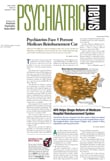Researchers at the National Institute of Mental Health (NIMH) have discovered a rare combination of two mutations within one gene that codes the serotonin transporter that together appear to lead to treatment-resistant obsessive-compulsive disorder (OCD).
The report may be the first in which two mutations within the same gene contribute to a psychiatric disorder.
The hSERT gene codes for the human serotonin transporter—the membrane protein responsible for the reuptake of serotonin from the synapse between two neurons. It is the transporter protein that is bound by serotonin reuptake inhibitors (SSRIs), resulting in blocking the transporter’s function and leaving more serotonin available for neuronal communication within the synapse.
The researchers at NIMH, along with Japanese collaborators, discovered a mutation within the hSERT gene, which they labeled I425V. The mutation appears to be associated with an increased expression of the hSERT gene, resulting in more transporter proteins appearing in the neuron’s membrane. This results in increased reuptake of serotonin in those neuronal synapses, decreasing the amount of serotonin available in the synapse for signaling.
The second mutation identified, a long allele of the promoter portion of the serotonin transporter gene (5-HTTLPR), results in similar cellular effects—an increase in transporter proteins leading to less serotonin being available for neuronal communication.
The two mutations appearing together result in a significantly lower amount of serotonin available within the synapse than is seen with either one of the mutations alone.
The research, funded by NIMH, was reported in the October 23 issue of Molecular Psychiatry.
A Double Hit
“In all of molecular medicine, there are few known instances where two variants within one gene have been found to alter the expression and regulation of the gene in a way that appears associated with symptoms of a disorder,” co-author Dennis Murphy, M.D., a researcher in the NIMH Laboratory of Clinical Science, said in a prepared statement. “This step forward gives us a glimpse of the complications ahead in studying the genetic complexity of neuropsychiatric disorders.”
Murphy and his colleagues studied the DNA of 170 unrelated individuals, including 30 with OCD, 30 with eating disorders, and 30 with seasonal affective disorder. The remainder served as healthy control subjects. Two patients with OCD were found to have the first mutation, I425V. The mutation did not appear in any other patients or control subjects.
Family Interviews Conducted
In addition, psychiatric interviews were completed with each patient’s families, revealing that five relatives of the two patients with the I425V mutation had histories of OCD or obsessive-compulsive personality disorder. Some also had anorexia nervosa, Asperger’s syndrome, social phobia, or a substance abuse disorder.
Further DNA analysis revealed that the two patients with OCD who carried the I425V mutation, as well as their two siblings, also had the second mutation in the hSERT gene—the 5-HTTLPR mutation. “This variant, associated with an increased expression and function of the serotonin transporter, suggests a double hit, or two changes within the same gene,” the authors noted.
The combination of the two mutations could account for the “unusual severity and treatment resistance of the illnesses in the subjects and their siblings.”
NIMH Director Thomas Insel, M.D., said, “This is a new model for neuropsychiatric genetics—the concept of two or more within-gene modifications being important in each affected individual. This is probably the first report of a modification in a transporter gene resulting in a gain rather than a decrease in [its] function.”
An abstract of the article is posted on the Web at www.nature.com/mp/journal/v8/n10/index.html. ▪
